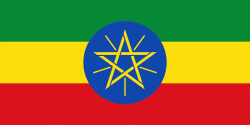Dembidolo (Dembī Dolo)
Dembidollo, (Dambi Doolloo), also spelled Dembi Dolo, is a market town and separate woreda in south-western Ethiopia. It is the capital of Kelam Welega Zone of the Oromia Region. This town has a latitude and longitude of 8.53333°N, 34.8°W with an elevation between 1701 and 1827 meters above sea level.
Dambi Dolo is known for goldsmith work and for tej production. The town also possesses an airport (ICAO code HADD, IATA DEM).
Originally known as Sayo, after the semi-autonomous kingdom that had ruled in this area in the years after 1900, by 1920 this town served as the seat of the governors of this part of south-western Ethiopia until the Italian conquest. Richard Pankhurst notes that during this period Dembidolo was "a great commercial centre for coffee, where by the 1930s perhaps 500,000 kilos of beans, besides large quantities of wax and skins, were exported every year to the Sudan." Emperor Iyasu V visited Dembidolo around 1912, and was welcomed by Dejazmach Jote.
By 1958 Dembi Dollo became one of 27 places in Ethiopia ranked as First Class Township. That same year, the Commercial Bank of Ethiopia opened a branch in the town. The last military action of the Oromo Liberation Front (OLF) before the demise of the Derg 1991 occurred at Dembi Dollo, when some of its units reportedly killed more than 700 government soldiers. Afterwards, the OLF assumed civilian control of Dembi Dollo and its surrounding territory. However, when the OLF found that their efforts to field candidates in the rest of the Oromia region were frustrated by the Oromo Peoples' Democratic Organization the OLF withdrew from the government in 1992. This proved to be a disaster for the OLF, as EPRDF forces captured Dembi Dollo and forcibly drove the OLF membership into exile.
Currently a modern water supply system is under construction in the town and will be completed by October 2017.
Dambi Dolo is known for goldsmith work and for tej production. The town also possesses an airport (ICAO code HADD, IATA DEM).
Originally known as Sayo, after the semi-autonomous kingdom that had ruled in this area in the years after 1900, by 1920 this town served as the seat of the governors of this part of south-western Ethiopia until the Italian conquest. Richard Pankhurst notes that during this period Dembidolo was "a great commercial centre for coffee, where by the 1930s perhaps 500,000 kilos of beans, besides large quantities of wax and skins, were exported every year to the Sudan." Emperor Iyasu V visited Dembidolo around 1912, and was welcomed by Dejazmach Jote.
By 1958 Dembi Dollo became one of 27 places in Ethiopia ranked as First Class Township. That same year, the Commercial Bank of Ethiopia opened a branch in the town. The last military action of the Oromo Liberation Front (OLF) before the demise of the Derg 1991 occurred at Dembi Dollo, when some of its units reportedly killed more than 700 government soldiers. Afterwards, the OLF assumed civilian control of Dembi Dollo and its surrounding territory. However, when the OLF found that their efforts to field candidates in the rest of the Oromia region were frustrated by the Oromo Peoples' Democratic Organization the OLF withdrew from the government in 1992. This proved to be a disaster for the OLF, as EPRDF forces captured Dembi Dollo and forcibly drove the OLF membership into exile.
Currently a modern water supply system is under construction in the town and will be completed by October 2017.
Map - Dembidolo (Dembī Dolo)
Map
Country - Ethiopia
 |
 |
| Flag of Ethiopia | |
Anatomically modern humans emerged from modern-day Ethiopia and set out to the Near East and elsewhere in the Middle Paleolithic period. Southwestern Ethiopia has been proposed as a possible homeland of the Afroasiatic language family. In 980 BCE, the Kingdom of D'mt extended its realm over Eritrea and the northern region of Ethiopia, while the Kingdom of Aksum maintained a unified civilization in the region for 900 years. Christianity was embraced by the kingdom in 330, and Islam arrived by the first Hijra in 615. After the collapse of Aksum in 960, a variety of kingdoms, largely tribal confederations, existed in the land of Ethiopia. The Zagwe dynasty ruled the north-central parts until being overthrown by Yekuno Amlak in 1270, inaugurating the Ethiopian Empire and the Solomonic dynasty, claimed descent from the biblical Solomon and Queen of Sheba under their son Menelik I. By the 14th century, the empire grew in prestige through territorial expansion and fighting against adjacent territories; most notably, the Ethiopian–Adal War (1529–1543) contributed to fragmentation of the empire, which ultimately fell under a decentralization known as Zemene Mesafint in the mid-18th century. Emperor Tewodros II ended Zemene Mesafint at the beginning of his reign in 1855, marking the reunification and modernization of Ethiopia.
Currency / Language
| ISO | Currency | Symbol | Significant figures |
|---|---|---|---|
| ETB | Ethiopian birr | Br | 2 |
| ISO | Language |
|---|---|
| AM | Amharic language |
| EN | English language |
| OM | Oromo language |
| SO | Somali language |
| TI | Tigrinya language |















